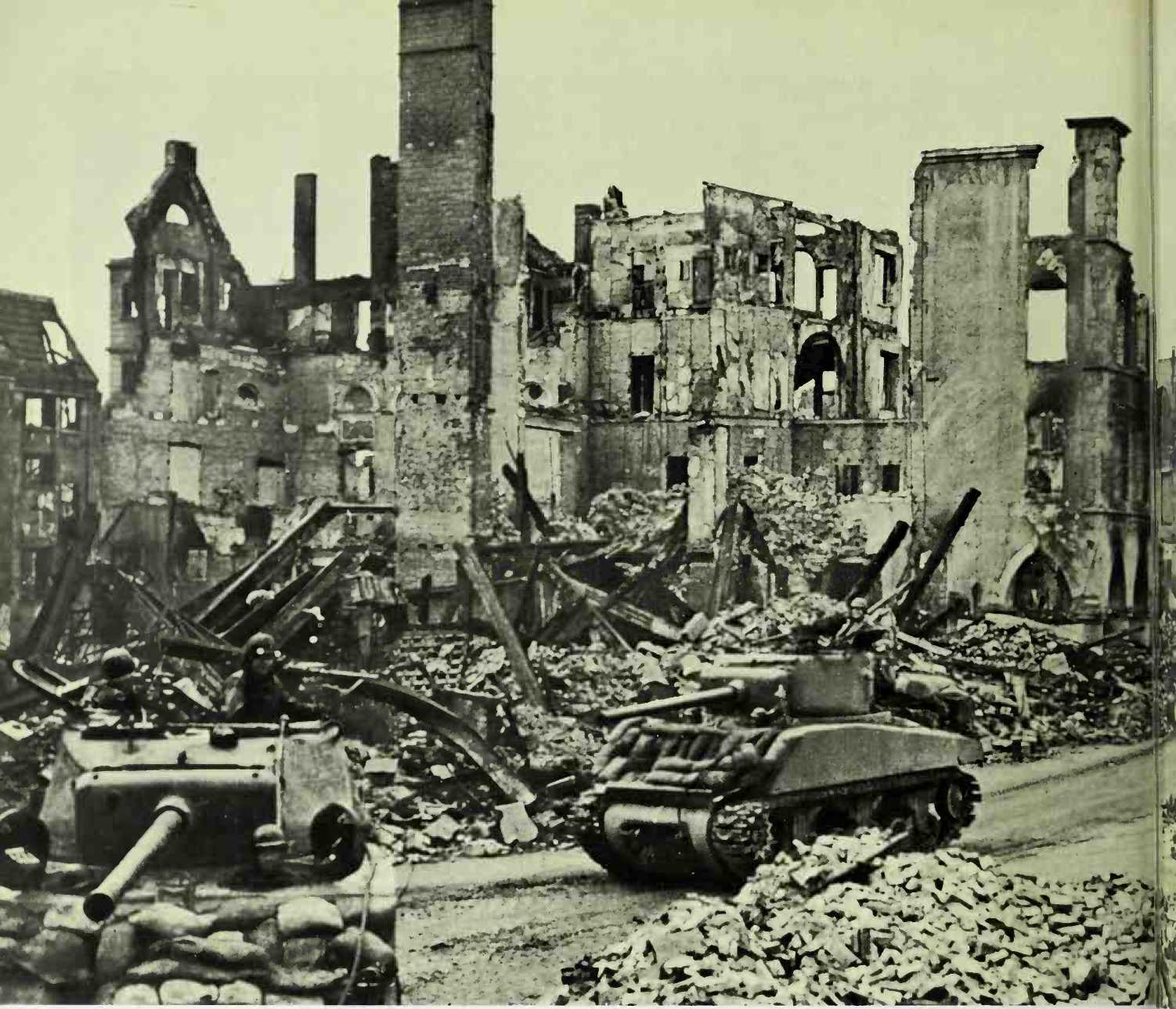On March 25, the American 1st Army began its fresh offensive by smashing LXXIV Corps in the region of Breitscheid. Hodges immediately unleashed his 3rd, 7th, and 9th Armoured Divisions, which reached Giessen and Marburg on the 28th, 53 and 66 miles respectively from the Rhine at Neuwied. On the same day, in the 3rd Army, Vlll Corps completed the mopping up of Frankfurt and made contact with Hodges’s right in the region of Wiesbaden,’thus trapping the enemy elements left on the right bank of the Rhine between the Lahn and the Main. But most strikingly, Patton’s 4th, 6th, and 11th Armoured Divisions, in formation ahead of XII and XX Corps, had moved from the Main valley into that of the Fulda, making in the direction of Kassel. Thus Hodges, whose task was to reach the eastern outlets of the Ruhr basin, found himself provided with cover, just as Bradley intended, against a counter-attack striking from the Harz mountains.
On the day after the surprise breakthrough at Oppenheim, Kesselring, according to his own account, had wondered "whether it was not best to accept the army groups’ proposals and withdraw the entire front from the Rhine. I finally refrained from doing so, because the only result would have been to retreat in disorder. Our troops were heavily laden, barely mobile, in large part battle-weary, and encumbered by units in the rear which were still in a state of disorder. The enemy had all-round superiority, especially in mobility and in the air. If nothing occurred to check or slow his advance, our retreating columns would be overtaken and smashed. This type of combat would have become an end in itself-no longer a means employed to an end-the end being to gain time. Every day on the Rhine, on the contrary, was a day
A American armour rumbles throiif’h the streets of Monchcngladbach in the Ruhr industrial area.

A Sherman tanks roll into the ruins of Munster on April 3.
Gained, signifying a strengthening of the front, even if it were only to enable points in the rear to be mopped up or stray troops to be rounded up.”
Quite clearly, at the point reached in the German camp on March 28, Kesselring’s conclusions were still more justified.
This was all the more true as the sappers of the 21st Army Group had by March 26 opened seven 40-ton bridges to traffic, and the American 9th Army and British 2nd Army came down both banks of the Lippe to overwhelm the 1st Parachute Army. Two days later, on the left bank of this river, Lieutenant-General Simpson had his 8th Armoured Division (Major-General J. M. Devine) in the region of
Haltern, more than 25 miles east of the Rhine. At the same time. Sir Miles Dempsey pushed the Guards Armoured Division (Major-General Allan Adair) down the Munster road, while his XXX and Canadian II Corps, on a line linking Borken - Bocholt - Isselburg - Emmerich, reached the Dutch frontier. The 1st Parachute Army was helplessly cut off, and its LXIII Corps and XLVII Panzer Corps (five divisions) were thrown back onto Army Group "B”. And Montgomery poured his armoured units resolutely into the breach.
On April 2, 1945, as the day closed, the inevitable happened. The American 3rd Armoured Division, driving ahead of

VII Corps (1st Army), met up at Lippstatt with the 8th Armoured Division coming from Haltern. In the course of this fighting, Major-General Rose, commanding the 3rd Armoured Division in its finest foray, was killed. Now Army Group ”B” was encircled, with the exception of LXVII Corps, which had been attached to Army Group ”B” following the breakthrough at Breitscheid.
Including the ruins of the 1st Parachute Army mentioned above, there were the 5th Panzerarmee and the 15th Army, of seven corps or 19 divisions (three of them Panzer, and the 3rd Panzergrena-dier Division) caught in a trap that Hitler was quick to qualify as "the fortified
Region of the Ruhr”. To reduce it. General Bradley formed a new 15th Army, under the command of Lieutenant-General Leonard T. Gerow, with a strength of five corps, including the newly-formed XXII and XXIII Corps, in all 18 divisions taken from the 1st and 9th Armies.
The encirclement of the Ruhr meant not only the rapid destruction of Army Group ”B”, but more importantly, the end of all organised resistance on the part of the Wehrmacht between Wiirz-burg on the Main and Minden on the Weser. Between the inside of the wings of Army Groups "G” and "H”, a breach of more than 180 miles was opened. It was too late for the unfortunate Kesselring to cherish the notion of repositioning his armies on a line along the courses of the Weser, Werra, Main, Altmuhl, and Lech, as favoured by 18th Century strategists.




 World History
World History









